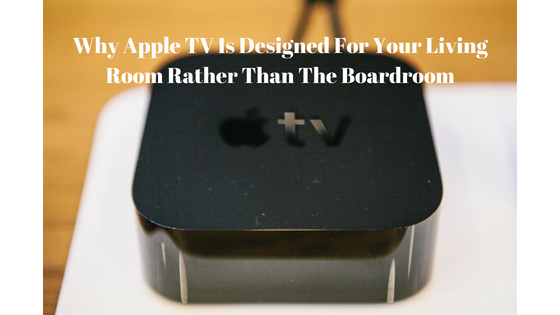
Why Apple TV Is Designed For Your Living Room Rather Than The Boardroom
What is holding Apple TV back from being a professional collaboration tool?
There have been numerous reviews of Apple TV, mostly in residential, personal-use scenarios. The initial launch of Apple TV was met with a lukewarm response, but the service has been iterated on several times, to the point where most of those early kinks have been worked out. This is not particularly relevant to professional users, save for one point – cost. Apple’s approach to product cost has always been fertile ground for discussion and debate, but the tech juggernaut’s refusal to compete on price makes little sense in an industry as competitive as business communications and conferencing. Apple TV costs three times as much as competing streaming boxes, with no clear justification as to why. Compared to those other streaming boxes, there are no standout features. This is even more apparent when comparing Apple TV to Crestron or Kramer products, which are designed specifically for a professional setting. But this is just one point, and price is not decisive for many companies. If it costs more for the ideal conferencing and collaboration solution, so be it. But is Apple TV that solution? Probably not for most companies, and here’s why:1. Apple TV locks users into the Apple ecosystem – Between Apple, Microsoft, Google and Amazon, it’s tough keeping all of these ecosystems straight. What is clear is that some brands are onerous when it comes to locking people into their devices, and Apple is notorious for this maneuver. This is less of a concern in a personal use setting, where families are less likely to be troubled by adopting Apple products across the entire household. Further, Apple is a highly diversified tech hardware manufacturer, and its foray into several industries does prevent its ecosystem from feeling confining, at least some of the time.
But in the professional world, there are many more devices to deal with, and many more users with their own device preferences. Even if a company goes all in on Apple products, a presenter will occasionally need their own device to present material, and they may prefer a different brand. Here, the Apple TV starts feeling unwelcome.
Apple doesn’t play nice with other ecosystems, so there is little official support from the brand in providing easy compatibility across other device platforms. There are third-party applications that can facilitate the use of Apple TV with Microsoft or Google devices, but being third party, they are naturally limited. And when they do work, they tend to represent a bottleneck, slowing the meeting down.
2. Apple TV requires HDCP – HDCP, or high-bandwidth digital content protection, is a form of piracy prevention that is panned by just about everyone who works with communication technologies. Developed by Intel, HDCP uses licensing to ensure that content is authorized for transmission to a particular receiver. Many tech manufacturers, including Apple, have been pressured into adopting HDCP encryption for their products, as the alternative is to face pressure from lobbyists and the licensing agency.
HDCP isn’t always a problem, and ideally, you’ll never notice it’s there. And in fact, it’s difficult to know just what devices and products are built with HDCP. This information is usually provided by the manufacturer somewhere, but isn’t always easy to find. Apple TV is one such technology, though.
This means that every device that utilizes Apple TV must also be HDCP compliant. While most modern displays are, if the display isn’t, then Apple TV won’t work at all. Imagine the frustration of discovering this on the day of a critical meeting.
3. Apple TV is considered a security hole by most A/V and IT professionals – Although Apple markets the technology for residential and business use, it hasn’t paired Apple TV with the requisite enterprise security. It’s not clear why this is the case, but perhaps it has something to do with the fact that the Apple TV is, first and foremost, a consumer product.
Whatever the reason, Apple TV is considered a security issue by many A/V and IT professionals. In fact, many college campuses and companies restrict Apple devices for this reason, and Apple TV is no different.
Conferencing technology built for the enterprise environment makes heavy use of random, and frequently changing, PINs to ensure only the meeting’s members are granted access to the device. This approach is not as developed with Apple TV, which means that anyone with credentials can access it at any time. What, then, is keeping someone from sending something to the Apple TV while a meeting is going on, and from another room?
In the future, perhaps Apple will work these issues out, but given the technology’s slow acquisition of market share, most believe that Apple will only halfheartedly support its TV product. As such, it’s best for companies to turn elsewhere, at least until Apple makes a better effort at configuring their technology for the professional sector.

